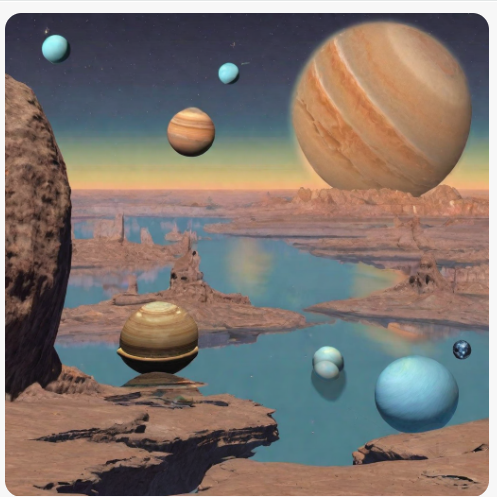New moons of Uranus and Neptune Stated
On February 23, 2024, astronomers announced the discovery of three new moons in our solar system: two orbiting Neptune and one circling Uranus. This brings the total number of known moons to 16 for Neptune and 28 for Uranus.
Uranus's new moon: This tiny moon, measuring just 5 miles (8 kilometers) wide, is the first new moon discovered around the ice giant in over two decades. It takes a whopping 680 days to complete one orbit around Uranus. Interestingly, it might even be the smallest moon orbiting Uranus new moon
Neptune's new moons: The brighter of the two new Neptunian moons, provisionally named "S/2002 N5," is 14 miles (23 kilometers) wide and seems to be in a 9-year orbit around Neptune. The fainter moon, currently named "S/2021 N1," is slightly smaller at 8.6 miles (14 kilometers) wide and takes a much longer 27 years to circle Neptune. Both moons will eventually be assigned permanent names based on sea gods and nymphs from Greek mythology. Neptune's new moons
These discoveries are significant because they help us learn more about the formation and evolution of our solar system. They also raise the possibility that there might be even more moons out there waiting to be found, especially around the distant ice giants like Uranus and Neptune.
On February 23, 2024, astronomers announced the discovery of three new moons in our solar system: two orbiting Neptune and one circling Uranus. This brings the total number of known moons to 16 for Neptune and 28 for Uranus.
Uranus's new moon: This tiny moon, measuring just 5 miles (8 kilometers) wide, is the first new moon discovered around the ice giant in over two decades. It takes a whopping 680 days to complete one orbit around Uranus. Interestingly, it might even be the smallest moon orbiting Uranus new moon
Neptune's new moons: The brighter of the two new Neptunian moons, provisionally named "S/2002 N5," is 14 miles (23 kilometers) wide and seems to be in a 9-year orbit around Neptune. The fainter moon, currently named "S/2021 N1," is slightly smaller at 8.6 miles (14 kilometers) wide and takes a much longer 27 years to circle Neptune. Both moons will eventually be assigned permanent names based on sea gods and nymphs from Greek mythology. Neptune's new moons
These discoveries are significant because they help us learn more about the formation and evolution of our solar system. They also raise the possibility that there might be even more moons out there waiting to be found, especially around the distant ice giants like Uranus and Neptune.
New moons of Uranus and Neptune Stated
On February 23, 2024, astronomers announced the discovery of three new moons in our solar system: two orbiting Neptune and one circling Uranus. This brings the total number of known moons to 16 for Neptune and 28 for Uranus.
Uranus's new moon: This tiny moon, measuring just 5 miles (8 kilometers) wide, is the first new moon discovered around the ice giant in over two decades. It takes a whopping 680 days to complete one orbit around Uranus. Interestingly, it might even be the smallest moon orbiting Uranus new moon
Neptune's new moons: The brighter of the two new Neptunian moons, provisionally named "S/2002 N5," is 14 miles (23 kilometers) wide and seems to be in a 9-year orbit around Neptune. The fainter moon, currently named "S/2021 N1," is slightly smaller at 8.6 miles (14 kilometers) wide and takes a much longer 27 years to circle Neptune. Both moons will eventually be assigned permanent names based on sea gods and nymphs from Greek mythology. Neptune's new moons
These discoveries are significant because they help us learn more about the formation and evolution of our solar system. They also raise the possibility that there might be even more moons out there waiting to be found, especially around the distant ice giants like Uranus and Neptune.
0 Commenti
0 condivisioni
1K Views




